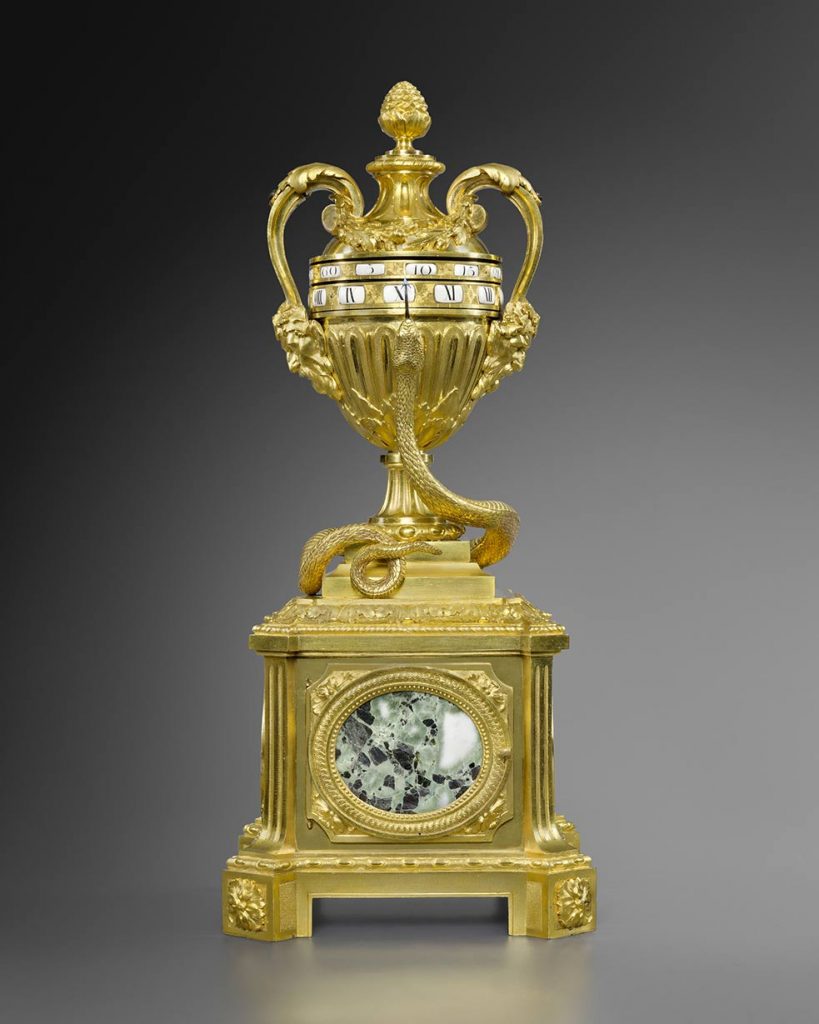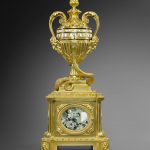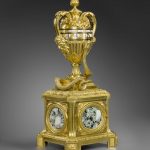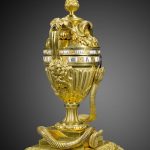A gilt bronze and marble vase clock

A late Louis XV gilt bronze and vert Antique marble vase clock à cercles tournants,
signed Courieult à Paris – circa 1770
The case by Jean-Baptiste Gaulier, maître fondeur in 1756
Gabriel Courieult, maître on 3 September 1767
Height: 40.5 cm. (16 in.) Width: 17.5 cm. (7 in.) Depth: 17.5 cm. (7 in.)
The clock operates as two horizontal gilt bronze circles indicating the hours and minutes with enamelled Roman and Arabic numerals which rotate around a fixed blued steel hand. The rectangular movement engraved with the signature has a recoil anchor escapement and wire suspension and strikes the hours and half-hours by means of a count-wheel mounted on the back-plate.
Provenance
Vassy & Jalenques, Clermont-Ferrand, 18 June 2005, lot 40
Madame Bert
Literature
- and A. Wannenes, Les plus belles pendules Françaises: de Louis XIV à l’Empire = The finest French pendulum-clocks: from Louis XIV to the Empire, Florence, 2013, p. 259 (ill.)
Comparative Literature
An identical vert Antique marble clock was sold from the Riahi Collection, Christie’s New York, 2 November 2000, lot 6.
A similar unsigned clock with oval painted copper plates representing genre scenes now in the musée du Louvre and formerly belonging to the Comte d’Orsay in his hôtel particulier on the rue de Varenne is illustrated in D. Alcouffe et al., Les bronzes d’ameublement du Louvre, Paris, 2004, p. 136, no. 63.
Another with Sèvres porcelain plates delivered by the marchand-mercier Poirier to Madame du Barry on 18 November 1768 is published in S. Eriksen, Early Neo-Classicism in France, London, 1974, pp. 347-348, no. 197 (private collection).
Jean-Baptiste Gaulier, a friend of the Caffieri
Jean-Baptiste Gaulier (sometimes Gautier) was born in 1734, the son of an employee of the Ormesson family and was apprenticed in 1747 to the maître fondeur Louis Mathieu Chambon,[1] a former apprentice of Jacques Caffieri (1678-1755).[2] He became a maître fondeur in Paris in 1756 and married in 1759 in the presence of Philippe Caffieri (1714-1774), a family friend[3] with whom he lived on rue Princesse. It was perhaps with the Caffieris that he developed a taste for novelty, as evidenced by this vase clock, the model of which seems to date back to 1768,[4] when he was elected juror of his community for two years.
He was among the creditors of the founder Étienne Forestier (d. 1768).[5] We find him in 1769 as a creditor to the estate of the marchand-mercier Henri Lebrun,[6] then with Antoine Magnien, another marchand-mercier, who established a business for selling gilt bronzes.[7] The overly innovative company went bankrupt in 1777, dragging Gaulier down with it. He never recovered and two years later put his business up for sale, composed of “andirons, wall lights, candelabra, clock and cartel clock cases representing mythological subjects (sujets de la fable)”.[8]
Christian BAULEZ
Conservateur général honoraire du Patrimoine
[1] A.N., M.C., ET/LXXXV/564, patent of 11 July 1747.
[2] A.N., M.C., ET/LXXXV/459, patent of 3 August 1736.
[3] A.N., M.C., ET/XCI/966, contract of 25 March 1759.
[4] J.-D. Augarde, Les ouvriers du Temps, Geneva, 1996, p. 137 and 199.
[5] A.N., M.C., ET/XIV/558, 29 April 1777.
[6] A.N., Y 15468, scellés of 4 July 1769.
[7] C. Baulez, ‘Le mobilier du Palais Bourbon’, in Le Palais Bourbon, sa place, Délégation à l’action artistique de la Ville de Paris, F. Magny (ed.), 1987, pp. 44-57.
[8] Petites affiches, annonces et avis divers, 25 July 1779, p. 1643, no. 206.



